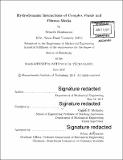Hydrodynamic interactions of complex fluids and fibrous media
Author(s)
Shahsavari, Setareh
DownloadFull printable version (23.62Mb)
Other Contributors
Massachusetts Institute of Technology. Department of Mechanical Engineering.
Advisor
Gareth H. McKinley.
Terms of use
Metadata
Show full item recordAbstract
Hydrodynamic interactions of fluids and fibers are encountered in many applications, from filtration processes to the development of novel materials such as nanofluids and nanocomposites, and even in biological systems such as transport of fluids in plants and tissues. It is therefore, valuable from both a scientific and engineering perspective, to understand and be able to predict the behavior of such systems. In this thesis, hydrodynamic effects arising from the presence of fibers in fluid flows are studied in two different scenarios: i) Newtonian and non-Newtonian fluids flowing through fixed arrays of fibers (fibrous media), and ii) fibers suspended in fluids and the rheological changes resulting from the fiber-fluid hydrodynamic interactions. First, the flow of Newtonian fluids through and at the interface of fibrous porous media is studied. The primary objective of this part of the thesis was the design and development of a microfluidic device incorporating fixed beds of carbon nanotubes for filtration of specific biomarkers from biological fluid samples. Therefore, the focus is centered on defining and evaluating an interception efficiency, which provides a measure of the fraction of fluid streamlines that intercept a porous collector. It is shown through numerical simulations, that in general, the effects of geometrical confinement as well as fluid inertia and porosity (as captured by the Reynolds number and Darcy number respectively) on the flow interception efficiency are interdependent; however, for most practical cases it is possible to decouple these effects (e.g. at Darcy numbers < 10-4). For the specific case of fibrous collectors consisting of carbon nanotubes, experimental studies are conducted to investigate the convection and diffusion of dilute polymer solutions through cylindrical paths of vertically aligned carbon nanotubes. The experiments demonstrate the ability to systematically control the thickness and uniformity of adsorbed polymers on the carbon nanotubes through variation in the geometrical confinement of the fibrous array. The studies of flow transverse to fibers are also extended to the case of non-Newtonian fluids. Emphasis is placed on theoretical development of general mobility functions for complex fluids flowing through fibrous media. This is one of the major contributions of this thesis, which yields generalized laws for predicting the pressure drop that an array of fibers induces on the steady flow of fluids with a yield-stress and a rate-dependent viscosity. The resulting formulation can be applied to various geometrical arrangements and a wide range of porosities. Based on this model, we construct a unified dimensionless criterion in the form of a modified Bingham number (or dimensionless yield stress) rescaled with a suitable porosity function, which incorporates all the rheological and pore-scale parameters that are required to determine the dominant viscoplastic regime. Finally, suspensions of fibers in a Newtonian liquid matrix are studied. In this case the fibers are allowed to be flexible and move within the suspending media in addition to having attractive potentials with each other. These degrees of freedom give the resulting fiber suspensions striking features such as viscoelasticity and ability to form a percolated gel network at volume fractions as low as ~ 3% for the system of interest, which consists of an aqueous suspension of nanocrystalline cellulose fibers (length 200nm, aspect ratio 20). The changes in the rheological behavior of these dispersed fibrous systems are investigated as the volume fraction of nanofibers are varied. Finally, the correlative technique of differential dynamic microscopy (DDM) is implemented to study the collective fiber dynamics and we demonstrate that this method can be used as a complementary technique to provide microrheological insight that extends the ability to rheologically characterize the steady and transient viscoelastic properties of complex heterogeneous fluids.
Description
Thesis: Ph. D., Massachusetts Institute of Technology, Department of Mechanical Engineering, 2017. Cataloged from PDF version of thesis. Includes bibliographical references (pages 171-183).
Date issued
2017Department
Massachusetts Institute of Technology. Department of Mechanical EngineeringPublisher
Massachusetts Institute of Technology
Keywords
Mechanical Engineering.